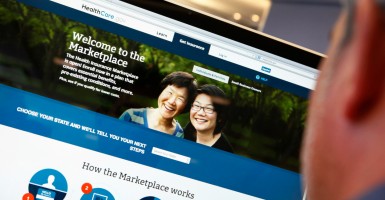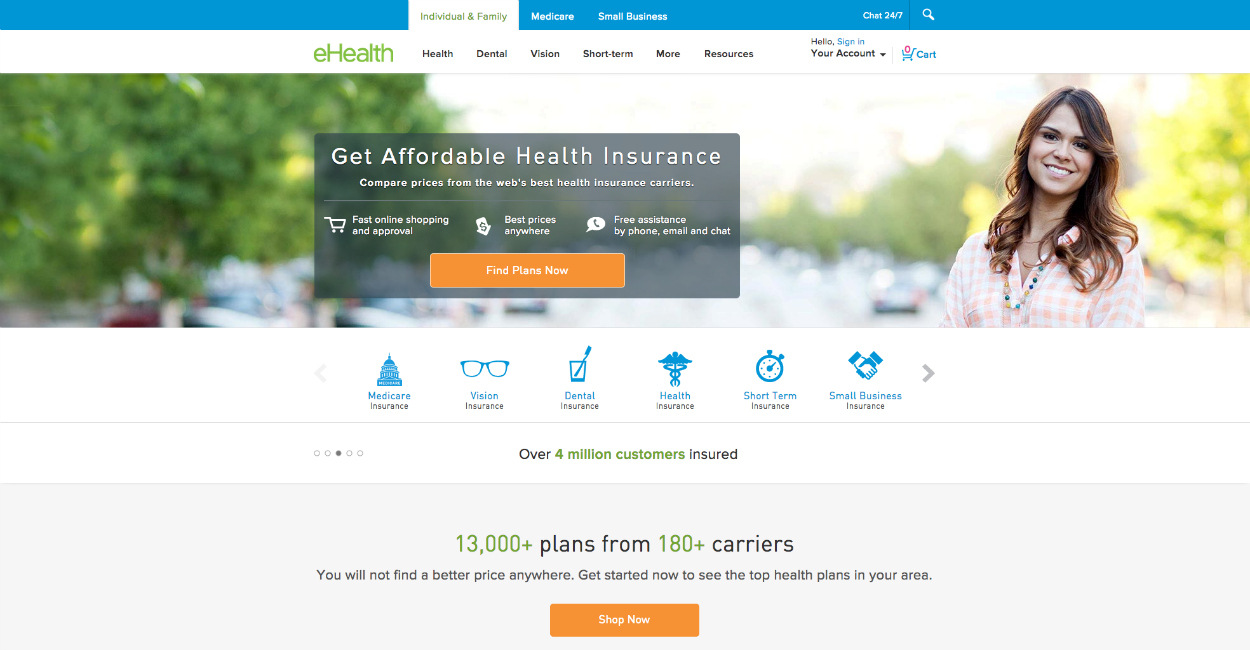California-based eHealth Insurance, a private health insurance exchange, announced it would be laying off 100 workers as a result of increased competition under the Affordable Care Act.
A second private exchange based in California, GetInsured, has seen its revenue grow substantially.
More than one year after the rollout of “Obamacare” the private exchanges competing with the Affordable Care Act’s federal insurance marketplace, HealthCare.gov, are experiencing mixed successes.
Private health insurance exchanges have been in the business of selling health care coverage for many years. But the launch of HealthCare.gov—the Affordable Care Act’s federal insurance exchange—brought a public-sector competitor into the market.
Three private web brokers—eHealth Insurance, GetInsured and GoHealth—were awarded contracts from the Centers for Medicare and Medicaid Services before the law went into effect. The contracts allowed the companies to enroll consumers eligible for subsidies under the Affordable Care Act in the 36 states using the federal exchange, HealthCare.gov, by giving them access to the federal data hub.
Kaiser Family Foundation estimated that roughly 17 million consumers would be eligible for subsidies in 2014, and for private exchanges like eHealth, GetInsured and GoHealth, HealthCare.gov became their competition once the site launched.
According to the most recent estimates, the federal exchange cost taxpayers close to $2 billion.
Now, 40 companies serve as web broker entities and have contracts with HealthCare.gov.
“In many ways we do compete with HealthCare.gov, and we’re also their partners,” Chini Krishnan, chief executive officer of GetInsured, said in an interview with The Daily Signal. “The way that we differentiate ourselves is we have an outstanding consumer experience, and we have invested a lot in giving consumers the tools they need.”
>>> Commentary: How King v. Burwell Decision Could Affect Obamacare Enrollees
A Boon and a Bust for Private Exchanges
The Center for Medicare and Medicaid Services’ contract with eHealth proved to be a boon for the company—which bills itself as the “nation’s first and largest private health insurance exchange”—at first.
In March 2014, as the end of the first open enrollment period neared, eHealth’s stock was at a high of $51 per share, according to MarketWatch.
Additionally, when HealthCare.gov launched on Oct. 1, 2013, eHealth appeared to have the upper hand compared to the federal exchange.
HealthCare.gov crashed, and eHealth’s chief executive officer, Gary Lauer offered to let his company run HealthCare.gov’s enrollment process for free.
“Mr President, we are ready to help you get this program on track promptly, with the cooperation of the federal exchange, if you allow us to take over the shopping and enrollment process in all 36 federal exchange states—without the cost to the taxpayer,” he wrote in a letter to the president.
Though the Centers for Medicare and Medicaid Services ultimately declined, eHealth also proved to have the upper hand on the government when it came to enrolling the millennial generation, or those between the ages of 18 and 34. That population was crucial to balancing the risk pool of enrollees and keeping premium costs low for HealthCare.gov consumers.
Of those who selected plans through eHealth from Jan. 1, 2014 to March 23, 2014, more than 45 percent were between 18 and 34 years old. Meanwhile, of those using HealthCare.gov, just 27 percent were young people.
GetInsured also experienced similar growth.
Krishnan told The Daily Signal the private exchange tripled its revenue and staff over the last three years. In between open enrollment periods, GetInsured employs roughly 350 people. During an open enrollment period—the company’s busiest time—they add 100 more workers.
Additionally, GetInsured served a majority of those who are eligible for subsidies. Of total GetInsured enrollees during the second open enrollment period, 90 percent qualified for tax credits.
HealthCare.gov sees similar margins.
“The Affordable Care Act has had a tremendous impact on our business,” Krishnan said. “It enabled us to take almost a decade of experience serving consumers and help them find insurance plans that fit their needs and their budget.”
“We were able to take all of that experience since 2005 and brought that into the public marketplace to help those who are eligible for tax credits and those who need health insurance to start enrolling,” he continued.
Though eHealth experienced gains from its partnership with CMS at first, the company saw drastic changes toward the end of 2014. And now, its stock sits at around $9.40 per share, according to MarketWatch.
Last month, Lauer announced eHealth would be working to reduce costs and laying off 15 percent of its workforce, or 160 positions. According to company documents filed with the Securities and Exchange Commission, eHealth employed more than 1,000 people as of Dec. 31.
In a statement announcing the layoffs, Lauer said the company had trouble enrolling individuals and families.
“While our current and projected unit economics for new sales of individual and family plans remain attractive, we recognize the need to adjust our fixed cost structure as the result of lower membership than we expected in our individual and family health insurance business,” he said.
EHealth renewed its contract with HealthCare.gov in 2014, but the company warned it would have trouble satisfying some of the contract’s conditions, hindering its ability to “compete” with the federal marketplace.
In an email to The Daily Signal, Lauer said the health care law has required those in the industry to change the way their operate. The law introduced seasonality into the industry and caused a shift to short-term insurance. But, Lauer said he views HealthCare.gov as more of a partner.
“In many cases, we believe they view us as competition and that’s a mistake,” Lauer said. “The goal of the ACA is to get everyone insured, and government should be looking at the private sector as a partner who can help them do that efficiently and effectively, with less cost to the taxpayer.”
>>> Marco Rubio Marks Fifth Anniversary of Obamacare by Rolling Out Alternative Plan
Marketing Private Exchanges
To strengthen the online exchange, eHealth detailed plans to build brand awareness through public relations and marketing efforts.
Since HealthCare.gov’s launch, the private exchange has seen drastic increases to its marketing and advertising budgets.
In 2012, the company spent $57.7 million on such efforts. In 2013, its marketing and advertising expenses grew to $71.6 million and dipped slightly the following year to $69.7 million. For 2015, eHealth reported increased spending on marketing and advertising because of the second open enrollment period.
During debate over the health care law in 2009, Sen. Bill Nelson, D-Fla., criticized the private sector for devoting a substantial portion of premiums to administrative costs.
“We need to ensure that the policy-holder’s premiums and the federal subsidies that are going into the purchase of private health insurance on the exchanges are used for actual medical care and not for the wasteful administrative spending and marketing and profits,” Nelson said.
However, the federal government spent more than $684 million in taxpayer dollars on marketing and advertising for HealthCare.gov in 2013, according to the Associated Press.
In the first three months of 2014 alone, the federal government spent $52 million on public relations efforts for the public exchange.
The Daily Signal requested information on how much money the federal government spent in 2014, but requests were not returned.
>>> Happy Birthday, Obamacare: 5 Years After Launch, Fact Checking the Law’s Promises
Building What Already Existed
To help raise awareness of private exchanges like eHealth, GetInsured and GoHealth, the three web brokers joined forces with Towers Watson—another web broker—to form the Association of Web-Based Health Insurance Brokers (AWHIB).
The group, formed officially in November, seeks to better educate policy makers, government technical staff and the public about how web brokers can enroll those previously uninsured.
“We are working together for a more seamless integration with government exchanges so private exchanges can use their expertise to scale subsidy-eligible enrollments, deliver high customer satisfaction and be a valuable partner to CMS,” Tom Tsao, executive vice president of eHealth and AWHIB’s vice president, said.
In an article in the Illinois Business Journal, Ed Haislmaier, health policy expert at The Heritage Foundation, advocated for a simplified tax credit design that eliminated the need for HealthCare.gov but allowed for consumers to purchase insurance through private exchanges.
“They could simply buy coverage directly from an insurer, or through a broker or website such as eHealthInsurance.com,” he said.
Meanwhile, when examining the construction of HealthCare.gov, Krishnan said he would’ve liked to have seen the federal government examine the role the private market could’ve played.
“I think it would’ve been wise to consider how the private market could have been the provider of what consumers need,” said Chini Krishnan, CEO of GetInsured.
“I think it would’ve been wise to consider how the private market could have been the provider of what consumers need,” he said. “I think it would’ve been wise to consider that early on and evaluate what kind of role the private market could play considering the consumer expertise we have. It would’ve been a great thing to consider.”
This article has been updated to include comments from eHealth CEO Gary Lauer.



























